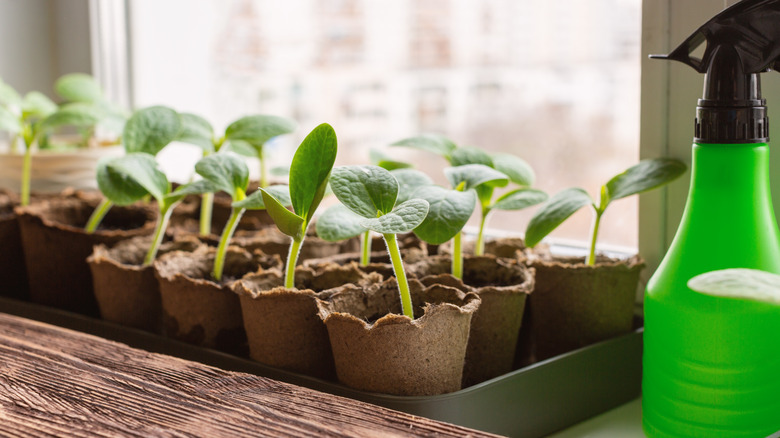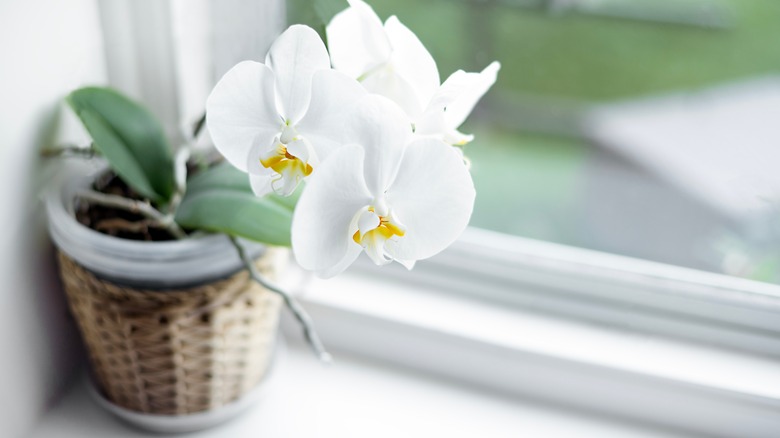Grow An Abundant Spring Garden With This Smart Seedling Gardening Tip
If you've got a green thumb, then you probably already know that some seeds require a moist, sunny location to germinate. Moisture is essential as it softens the seed coat, allowing water to penetrate and initiate biochemical changes within the seed. Sunlight becomes crucial because it stimulates the activation of plant hormones, which are responsible for the development of the plant. Additionally, sunlight provides the energy needed for photosynthesis once the seedling emerges. This combined influence of moisture and sunlight creates an optimal environment for successful germination and the emergence of healthy seedlings. One way you can help your seeds germinate is by creating a greenhouse effect within a resealable plastic food storage bag.
Some seeds germinate well in a sealed plastic bag due to the controlled environment created within the bag. The sealed enclosure retains moisture, creating a humid atmosphere that aids in softening the seed coat and initiating germination. This method offers a consistent and regulated microclimate, fostering optimal conditions for seed germination. Seeds that typically benefit from germinating in such an environment are often those that might face challenges in natural garden conditions. Certain herbs, like basil or oregano, may benefit from this method as they require consistent warmth and moisture for optimal germination. Additionally, some flowers with delicate seeds, such as snapdragons or impatiens, can benefit from the controlled environment to ensure successful and uniform germination. Not all seeds require this method and you should check the individual seed packet instructions for best practices.
How to use a plastic bag to germinate seeds
To give this method a shot, you'll need a wet paper towel, the seeds of your choosing, and a resealable plastic bag. To begin, place the seeds you want to germinate on a damp paper towel. The paper towel serves as a medium to keep the seeds moist and encourages the germination process. Place the damp paper towel on a flat surface and evenly distribute the seeds on one half, ensuring they are well-spaced. Fold the other half of the paper towel over the seeds. Carefully slide the paper towel with the seeds into a sealable plastic bag. Remove any extra air pockets and then seal the bag closed. This enclosed environment promotes humidity, creating a conducive atmosphere for seed germination.
Be sure to label the bag with the type of seed you've started, especially if you intend to start a variety of seeds in this way. Many seedlings are difficult to tell apart, yet they have specific care requirements, so differentiating between them is important. Find a sunny window where the plastic bag can receive ample sunlight and place the bag on the windowsill with the seeds facing the sunlight. Check the paper towel regularly to ensure it remains damp, misting it with water if needed. Over the next few days, you should observe the seeds beginning to sprout. Once the sprouts have reached a desirable size, they can be transplanted into soil for further growth.
Some seeds that won't benefit from this method
While the plastic bag method may work to germinate some seeds, it is not best for all types of plants. Orchid seeds, for example, are often grown using a technique called flasking. Orchid seeds are extremely tiny and lack endosperm, a nutrient-rich tissue found in most seeds. Flasking involves placing orchid seeds in a sterile nutrient medium inside a glass flask. This method allows for controlled conditions and provides the necessary nutrients for the seeds to germinate. In this case, the damp towel in a plastic bag method is unsuitable for orchid seeds due to their small size and specialized needs.
Conifer seeds, such as those from pine or spruce trees, have hard seed coats that may require stratification for successful germination. Stratification involves exposing the seeds to a period of cold, mimicking winter conditions. This can be achieved by placing the seeds in a damp substrate, like peat moss, inside a plastic bag and then refrigerating them for a specified period. The cold and moist conditions break down the seed coat, allowing for germination. Unlike the sunny window method, stratification addresses the specific dormancy requirements of conifer seeds.
Finally, marigolds are colorful and hardy flowers that thrive when directly sown into the garden. Marigold seeds can be sown in well-drained soil after the last frost date. Choose a sunny location and sow the seeds directly into the soil, covering them lightly. Successful germination usually takes between five and seven days.

